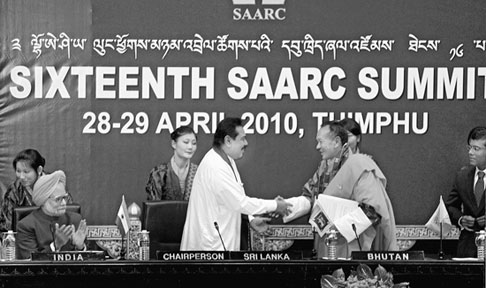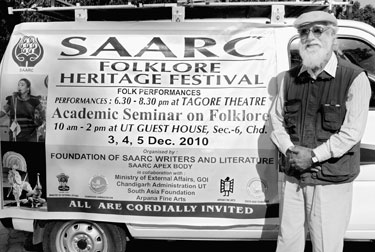|
25th anniversary on December 8:
A watershed year for SAARC
By Pramod de Silva
The South Asian Association for Regional Cooperation (SAARC) is 25
years old this year. December 8 marked the 25th anniversary of the
signing of the SAARC Charter. A grouping of India, Pakistan, Sri Lanka,
Nepal, Bhutan, Maldives, Bangladesh and Afghanistan, SAARC has firmly
established itself as a leading regional bloc. After all, SAARC
represents more than one-fifth of humanity.
|

President Mahinda Rajapaksa with other SAARC leaders at the
16th Summit |
South Asia was not always thought of as a distinct geographical or
political area. It has come a long way in some aspects, but stagnated in
some areas. There is a long way for SAARC to go.
The idea of a South Asian bloc was first mooted in the 1970s. It was
President Ziaur Rahman of Bangladesh who proposed the creation of a
trade bloc consisting of South Asian countries. The Bangladeshi proposal
was accepted by India, Pakistan and Sri Lanka during a meeting held in
Colombo in 1981. In August 1983, the leaders adopted the Declaration on
South Asian Regional Cooperation during a summit which was held in New
Delhi. But the first summit was actually held two years later.
The Heads of State of seven South Asian Countries of SAARC
(Bangladesh, Bhutan, India, Maldives, Nepal, Pakistan and Sri Lanka)
signed the Charter to establish the South Asian Association for Regional
Cooperation (SAARC) on December 8, 1985. Afghanistan joined SAARC as a
Member at the Fourteenth SAARC Summit, in New Delhi, April 2007.
The objectives of the Association as defined in the Charter are:
* To promote the welfare of the people of South Asia and to improve
their quality of life;
* To accelerate economic growth, social progress and cultural
development in the region and to provide all individuals the opportunity
to live in dignity and to realise their full potential;
|

SAARC Heritage Festival was held recently |
* To promote and strengthen collective self-reliance among the
countries of South Asia;
* To contribute to mutual trust, understanding and appreciation of
one another’s problems;
* To promote active collaboration and mutual assistance in the
economic, social, cultural, technical and scientific fields;
* To strengthen cooperation with other developing countries;
* To strengthen cooperation among themselves in international fora on
matters of common interest; and
* To cooperate with international and regional organisations with
similar aims and purposes.
As the SAARC Secretariat points out, SAARC is a unique concept of
regional cooperation. With distinct geographical, cultural,
environmental diversity, the SAARC Member States encompass the world’s
highest mountains as well as one of the smallest low-lying island
nations in the world.
The SAARC Secretariat was established in Kathmandu in January 1987,
just two years after the first Heads of State Summit. Since then, there
have been 16 summits and the last one was held in Thimphu, Bhutan.
Incidentally, this was the first time that Bhutan hosted the SAARC
Summit. The 15th Summit was held in Colombo in August 2008.
Principal activities
On the SAARC Charter Day all Member States hold celebrations to raise
public awareness of the commitment of governments to the SAARC process
and to highlight some of the principal activities and the work of the
association.
The Charter states that the South Asian States are desirous of
promoting peace, stability, amity and progress in the region through
strict adherence to the principles of the United Nations Charter and
Non-Alignment, particularly respect for the principles of sovereign
equality, territorial integrity, national independence, non-use of force
and non-interference in the internal affairs of other States and
peaceful settlement of all disputes.
It also notes that in an increasingly inter-dependent world, the
objectives of peace, freedom, social justice and economic prosperity are
best achieved in the South Asian region by fostering mutual
understanding, good neighbourly relations and meaningful cooperation
among the Member States which are bound by ties of history and culture.
Despite criticism, SAARC Members have made considerable progress in
this direction and in several recent meetings the Heads of State or
governments of Member States of SAARC have taken some important
decisions and bold initiatives to strengthen the organisation and to
widen and deepen regional cooperation.
SAARC has laid more stress on “core issues” affecting the people
rather than more decisive political issues affecting bilateral links.
SAARC, as a whole, has also refrained from interfering in the internal
matters of its Member States, but terrorism, which has affected most
Member States to varying degrees, has always been discussed.
Trade has been one of the most important topics discussed at SAARC
Summits. Intra-regional trade is low compared to the region’s trade with
the outside world. This is a matter for concern, as SAARC itself is a
huge market. At the 12th SAARC Summit held in Islamabad, SAARC countries
devised the South Asia Free Trade Agreement which created a framework
for the establishment of a free trade area covering 1.6 billion people.
This agreement went into force on January 1, 2008. However, this has
still not reached its fullest potential.
Missed opportunities
As the trade example shows, SAARC is yet to achieve the holy grail of
full regional unification. In fact, many people in the SAARC region are
frustrated with the slow pace of regional unification. SAARC leaders
themselves have turned the searchlight inwards and found that SAARC has
missed many opportunities for progress and further integration. The next
25 years should prove to be challenging to all SAARC nations in this
light.
|

Nalanda, site of the proposed SAARC University |
The Thimphu Silver Jubilee Declaration has noted that SAARC had not
achieved its potential even 25 years after coming into being. They have
wisely decided to have a Vision Statement and set up a ‘South Asia
Forum’ for the generation of debate, discussion and the exchange of
ideas on South Asia and its future development.
The Forum will consist of eminent personalities of diverse
backgrounds including all SAARC Member States. The Forum would provide
inputs, based on a comprehensive understanding, for charting out the
future course of SAARC in the medium and long run and recommend, if
required, improvements.
Apart from the firm resolve to address trade issues and combat
terrorism in all its forms, SAARC has made headway in some other aspects
as well. The establishment of a SAARC Development Fund (SDF) at the 16th
Summit was a step in the right direction as all eight SAARC nations are
still tagged as developing or emerging countries. This should hopefully
reduce SAARC’s dependence on outside (read donor nations and IMF/World
Bank) for development needs and funding. The permanent secretariat of
the fund will be based in Thimphu.
The SDF, like the IMF and ADB, will serve as a regional funding
mechanism to fund various social, economic, and infrastructure projects
in the region. ‘Trade not aid’ should be the formula for SAARC as it
seeks to uplift the living standards of the South Asian people.
Education is another subject that has been addressed by the SAARC
leaders, who proposed the establishment of a SAARC University in Nalanda,
India. They also launched a SAARC Food Bank to ensure food security in
the region.
One of SAARC’s biggest problems is the lack of a South Asian identity
and people-to-people contact. If I can think of myself as South Asian, a
citizen of SAARC, instead of thinking as a Sri Lankan or an Indian, half
the battle would have been won. Unfortunately, this is not the case.
SAARC citizens require visas even to visit their neighbouring
countries. Only Sri Lanka and Maldives have relaxed visa regulations.
Thus empowering its citizens should be a priority for SAARC. There is a
case for greater cultural interaction between SAARC peoples, as
exemplified by the recent SAARC folk arts festival.
Regional unity
The lack of free movement of people and goods is a huge dent in the
SAARC concept of regional unity. True, even the European Union took a
long time to become a borderless entity, but SAARC should at least now
move in that direction. Apart from borderless travel, South Asians would
like to see more transport options between at least their key cities.
SAARC should expedite their part of the work on the proposed Pan-Asian
rail network. Many SAARC capitals are still not linked to each other by
air, so intra-regional travel and tourism is still in its infancy. There
should be more ferry services - the recommencement of the Sri
Lanka-India ferry services is a welcome move.
The SAARC region should also explore the possibility of issuing a
common visa for tourists from other regions, a la European Union’s
Schengen, a move which will benefit all eight nations. Expansion and
openness should bring progress and prosperity.
A common currency is another option. This is very much a long-term
concept, but an interesting one. Several SAARC leaders have spoken in
favour of this concept. This should be a distinct possibility as South
Asia integrates its economy further.
SAARC cannot progress unless some of its Member States resolve their
bilateral disputes. Peace in the SAARC region is vital for its political
and social stability and development. As long as the region is mired in
conflict, as long as it is affected by terror, as long as its people do
not embrace a South Asian identity, SAARC will not realise its true
potential.
Ultimately, it is SAARC itself that should evolve solutions to its
problems from poverty alleviation to trade to development. SAARC must
strengthen its ties with the Observer States and other regional blocs
and raise its collective voice in international fora.
SAARC must literally become one nation in its quest to uplift the
living standards of its citizens and develop the region.
|

